The Yankees and their four greatest teams that almost were


Yankees history is filled with some of the all-time great teams. That has as much to do with luck as skill and planning, which is why we celebrate those iconic teams. But even with all of their success, the Bronx Bombers have had a few teams that were good but not all-time great. Here is how close the Yanks came to adding four other teams to the list of the best ever.
The 1927 Yankees. Three short words that make up one big sentence. Just the mention of that team, the GTOAT (Greatest Team of all Time), conjures not just thoughts of that team’s excellence, but of the other all-time great Yankees teams over the decades.
But I am not talking about all the teams that won World Series’. That makes the team great, but not all-time great. No, I am talking about the ‘39 Yankees team, as well as those of 1961, 1998, and 1932; those teams that are among the best to play this game.
I have used as my reference source Baseball Almanac. While I used the “Top 10 Rankings” box, you should take a peak at the next box down: Teams Post-1920 Only.
Those are all legendary teams. The Yankees have had more than their fair share of them; just ask the Red Sox. I say fair share because it takes a lot of disparate factors to produce that type of club, luck being perhaps foremost among those factors. The Yankees have had a lot of luck over the years.
What If?
This year will serve as an acceptable example. The offense has been great and the starting pitching has been pretty good. But it is still likely that the 2017 New York Yankees do not have enough talent to be one of the greatest, or even very good. The point of this article is that they have the talent to be better, but luck has not been on their side.
Greg Bird, for instance, is on the team. He has had success at the big league level and looked like the best player in baseball in spring training. But flukey injuries have kept him off the field the entire season.
Gleyber Torres has not had any time in the Bronx, but he has more talent that even Bird. Remember that Joe Girardi has already compared him to a young Miguel Cabrera. And Joe should know because he managed the Marlins and Miggy when Cabrera was 23. He came in fifth in the MVP voting that year; that’s a comforting comparison.
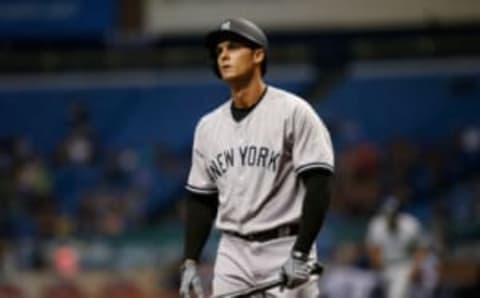
Imagine this team with Bird at first for the season and Torres at third by the middle of June. That might make them one of the best offenses of all time.
And let’s imagine for a moment that Tanaka had pitched up to his potential, as is reasonable. Those two factors, increased offense, and defense would add six or seven games to their win total.
That would still not make them a great team and certainly not an all-time team. The point, though, is they have everything they need to be a better club and could be if they had had better luck, but it just hasn’t worked that way.
Pure Yankees Speculation
There are four Yankees teams, better than the current one, that were good or even great but could have been better than that, could have been contenders for best team of all-time. My criteria, however, is very narrow. I never suggest a team could have been better by adding another great player. Any team can do that. And I do not look at short-term injuries, like missing the playoffs. That also happens to most teams.
And I am not going to get into the lost war years for Joe Dimaggio. Most of the teams lost their best players so any analysis would have to include the entire AL. I’m not doin’ that.
No, the teams discussed had all the pieces, but something major prevented them from reaching their potential. Whether it was injury, bad luck, or even death, these Yankees teams almost had it all. And we start with the 2009 World Series Champion New York Yankees.
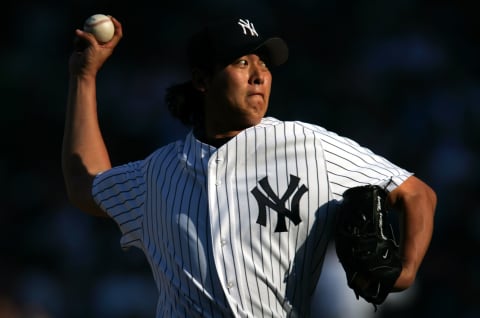
Drawing to a Pair of Aces
That 2009 Yankees team sure was a fun one. After missing the playoffs in 2008, the Yankees used the money from expiring contracts to infuse the Core Four—Jeter, Posada, Pettitte, and Rivera—with talented free agents. In walked starting pitchers CC Sabathia and A.J. Burnett, along with 1B Mark Teixeira and RF Nick Swisher.
Previous years had seen them sign FA’s Hideki Matsui and Johnny Damon and now both would enjoy their last good year in the majors. When the team was done being constructed, it had a potent mix of veterans, mid-career guys, and young players, including 2B Robinson Cano, LF Melky Cabrera, and C Francisco Cervelli. All three were 26 or younger.
And the team did not waste the talent. After a sluggish April filled with some tough losses, the team took off and won a league-best 103 games. They completed their march to win title 27 by going 11-3 in the postseason. Teixeira and Jeter finished second and third in the MVP voting (behind Joe Mauer), while CC finished fourth for the CY Young (winner, Zack Greinke).
That team, however, could have been a lot better. And that’s because of the team’s best pitcher and player, Chien-Ming Wang, fell to a non-pitching injury.
Why I Hate Interleague Play
Wang has been largely forgotten by Yankees fans but he was arguably the best pitcher in baseball from 2006 to 2008. He won 19 games each in those first two years and, even though he collected only 8 victories in 2008, he still had the most wins over that three-year stretch of any pitcher in the AL. He even came in second in the CY Young voting in 2006 (Johan Santana).
2008, however, saw Wang suffer a needless injury: He hurt his foot running the bases during an inter league game. The Yankees assumed he would recover and Chien-Ming was the 2009 opening day starter, over CC. That start was horrible, as were all future starts, and Wang was finished as an effective starter.
Of course, the Yankees did not know that in the off-season so, when they built their club, it was with the vision that Wang would lead the staff. Think about that. Wang would have been the number one starter, and it is safe to project 18 wins and an ERA of 3.70. That pushes CC, with his 19 wins and 3.37 ERA to second in the rotation, and A.J. (4.07) to third.
Who the Hell is Sergio Mitre?
And there are 18 games in particular that show the possible difference. Nine were started by Sergio Mitre and his 6.79 ERA, while the now-compromised Wang started the other nine. Only the 2009 Chien-Ming pitched to a 9.64.
If the Yankees had had the same Wang they had from ‘06-’08 and only lost to a fluke injury, those 18 games might have come out a lot different. Even if they won half of those games, their record would have been 112-50. Now that’s an all-time team.
I also think it’s fair to speculate they would have lost fewer games in the postseason, with the best one-two pitching combination in the playoffs. Had that team won 112 games and lost only once in the postseason, they might go to the Mount Rushmore of teams; maybe.
And I think that would have been true in 1979, as well.

The Dynasty that never Was
The Yankees appeared in three straight World Series from 1976-78, winning two of them. And they had every reason to believe they might go to a fourth.
The team was led offensively by candy bar aficionado Reggie Jackson, who finished with the most home runs on the team (29), tied with Sweet Lou Piniella for the highest average (.297), and was second in walks (65).
And Reggie had more playoff history and success than his teammates. He had previously led the Oakland Athletics to three straight World Series (72-74). They won all three although Jackson did not play in the ’72 Series.
But the emotional leader of the team and fellow middle of the order batter was C Thurman Munson. Munson was a hard-nosed player who had won Rookie of the Year in 1970 and MVP in 1976. By 1979, he was still the best at his position, even with declining numbers.
Of course, that team was loaded with talent besides those two. 24-year old Willie Randolph played second and worked 95 walks that year, fourth-most in the AL. Bucky Dent, at just 27, played shortstop and was the hero of the 1978 play-in game against the Red Sox.
And over at third was the 34-year old grizzled veteran and all-around tough guy Graig Nettles. His defensive wizardry almost single-handedly won the WS that Dent had gotten them to. Nettles hit 20 home runs in 1979, three fewer than DH Jim Spencer, but two more than 1B Chris Chambliss.
The team was loaded with power and speed, especially with Mick the Quick, Mickey Rivers, splitting CF duties with Bobby Murcer.
RIP, Thurman Munson
But on August 2nd, 1979 Thurman Munson died when the plane he was piloting crashed during landing.
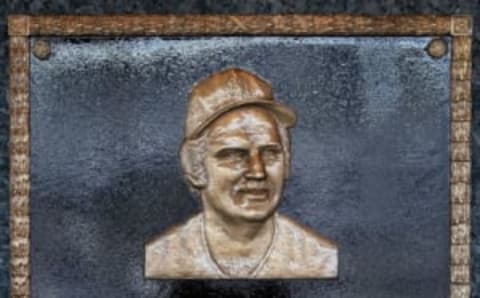
The team played inspired ball after his death but still missed the playoffs, at that time only two rounds. Had he lived, that team might have gone on to become one of the Yankees greatest.
That might seem like a stretch when you look at their record and consider they never even made the playoffs. But the numbers need a little perspective.
On August 2nd, 1977 the Yankees record was 59-46, just thirteen games over .500. But this was always a second half team, and they turned it on in the last two months. Their record by season’s end was 100-62, 38 games over, and in first place. They went on the win the WS.
On August 2nd, 1978, their record was 59-47, twelve games over. However, by season’s end, their record was 99-63, 36 games over and tied for first. They won 100 games (due to the play in game), but I don’t count the extra Yankees win just to keep somewhat accurate comparisons. This team also won the WS.
Can You See a Pattern?
The same was true in 1979. On August 2nd, the day Munson died, the Yankees record was 58-48, ten games over. And just like in previous years, they made a strong second half push. They finished 18 games over (89-71) but in fourth place. But this time they did not have their leader.
Instead, Jerry Naron and Brad Gulden split the catching duties for the rest of the season. When he passed, Munson was slashing .288/.340/.374. Naron put up a .171/.226/.309 line, while Gulden posted a slash of .163/.238/.207. And of course, no one could replace the leadership that Munson provided.
So the Yankees made their usual charge but without one of their two best players. Had he lived, and the Yankees made the postseason, Munson might well have proved as adept at post-season hitting as he had during his career. His overall postseason slash is .357/.378/.496.
The other big reason this team made this list is that most of the Yankees were having better years in 1979. Willie’s strikeouts were down, and his walks were up; Chambliss went from 12 home runs to 18; and, Mickey went up from an AVG/OBP of .265/.302 to .287/.315. But Reggie was having a much better year.
His home run total was relatively the same—27 in ‘78 and 29 the next year—but most of his other numbers went up significantly. Jackson slashed .274/.356/.477 in 1978 with 13 doubles and 133 strikeouts, all while collecting 244 total bases.
Going Up
Things got better in ’79. Reggie slashed .297/.382/.544 with 24 doubles and only 107 SO’s, adding up to 253 TB’s.
Those improvements might not seem that big, but Jackson played 46 fewer games in 1979. That means he was much more productive in each game that he played then in the previous year. I think we can project that rested and ready, he might have had one of his best postseason’s, as well.
Had they won their third WS in a row, and done it with their best team, they might very well be on a top ten list somewhere.
That is a lot of guessing and projecting. I don’t need to do nearly as much when it comes to the 1952 Yankees.
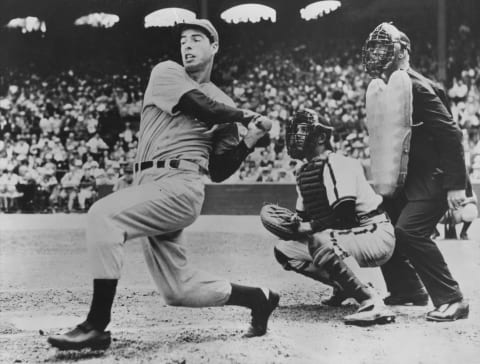
Mr. Coffee
The most successful run in Yankees franchise history was from 1949-53. The Bronx Bombers won the WS every year, but none of those teams is considered one of the greatest of all time. But with just one change, the ‘52 team might have been.
1951 was one of the most pivotal in pinstripe history: It was Joltin’ Joe Dimaggio’s last year, and Mickey Mantle’s first. Joe was 36 in 1951 and had the worst year of his career. In his 415 AB’s, his second fewest ever, he slashed .263/.365/.422, which pales in comparison to his career numbers: .325/.398/.579. He did manage to put up 12 home runs, however.
Dimaggio, ever proud, could see the handwriting on the wall. Plus, his replacement was already on the team in The Mick. Instead of being a compromised player, albeit one who was still better than most players in the league, Joe retired in November of that year.
But he didn’t have to. And had he made a different choice, that 1952 team would have elevated to a mythic level.
Where Joe Already Is
And one reason is that Mantle had his first big year in ’52. Well, big for most players but still far below what the Mick would go on to do. His fine 1951 rookie slash of .267/.349/.443, along with 13 home runs, was just a sample of his abilities. The Mick posted a .311/.394/.530 slash to go with his 23 home runs the next year.
Not only did he do more damage with every at-bat, but he also got a lot more chances in ’52. Mantle went from 341 AB’s to 549. But Mickey was not the only improved player from a team that won the WS the previous year.
Johnny Mize played 1B in 1951 when he hit .259 with 10 homers. Mize was still on the team the following season but it was Joe Collins who got most of the plate appearances, hitting .280 with 18 home runs. A similar change was made at second base where Billy Martin took over from Jerry Coleman. Martin had a better BA–.267 to .249—as well as a better slugging percentage: .344 to .315. But it was his hustle and baseball IQ that really helped the team.
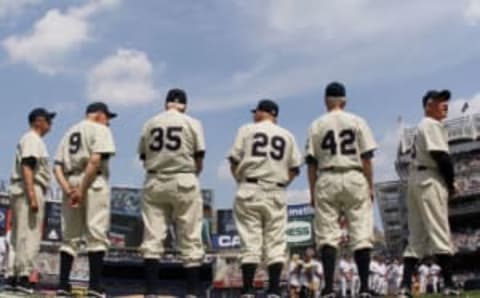
The outfielders also largely improved. Gene Woodling went from .281/.373/.462 to .309/.397/473, while OF Hank Bauer’s numbers stayed largely the same except he went from 10 home runs to 17. Even the always phenomenal C Yogi Berra was able to drive three more home runs and add ten RBI’s from one year to the next.
Irv Noren, Really?
This was an improved team, even younger than the one from the previous years. And those teams had won three World Series in a row. Joe could have stayed on this team, as the fourth outfielder. His numbers might have rebounded if he were to only get 320 AB’s or so.
But even if they didn’t, his 1951 numbers would still be good for a back-up, especially when compared to the man who was the primary replacement outfielder in 1952: Irv Noren. Irv (nickname unknown) got 272 AB’s that year and slashed .235/.316/.353 with five home runs. What might had this team been if Joe had gotten those AB’s?
And it’s not just about numbers, especially with 3-time MVP Joe Dimaggio. By all reports, he maxed out on intangibles. He is still considered by some to be the perfect ballplayer. Opponents would continue to be in awe of the Great Man, and his presence alone would be good enough for a half dozen wins.
It is possible that the 1952 New York Yankees could have added six wins to their total. That would have given them 102 and the most wins of any of those dynasty teams. Remember that they only played 154 games in those years. It might not have taken them seven games to beat the Dodgers, who had 96 wins that year.
If so, if all of those hypotheticals had happened, then the 1952 Yankees might be in the debate for GTOAT. And one additional team in that conversation might have been the 1938 Yankees.
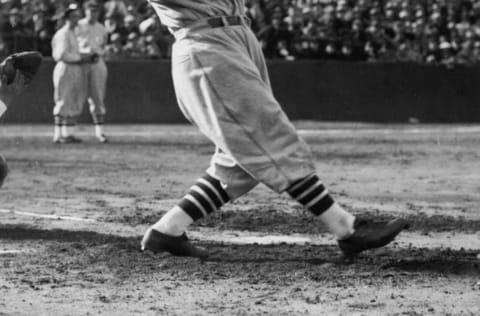
The Iron Horse
1938 found the Yankees in the middle of their first true dynastic run, winning four in a row from ’36-’39. And once again, Joe Dimaggio was in the midst of it. Except this was young Joe, and there was nothing lacking in his numbers.
He slashed .324/.386/.581 and knocked 32 balls out of the park. The man collected 140 hits while he walked 59 times and only struck out 21 times, in his 599 AB’s.
More from Yanks Go Yard
- Mets stealing New York Post’s entire Yankees offseason plan is hilarious
- Predicting Yankees-Diamondbacks LF trade package after Ken Rosenthal update
- Yankees add to championship core with Wilmer Difo signing
- Aaron Judge’s ‘breadcrumbs’ showed he was never leaving Yankees, has more moves in mind
- Creating a Yankees-Bryan Reynolds trade package after latest Pirates update
Even in what was for him an off year, Dimaggio put up all-world numbers. But just like in 1952, ’38 was a year of transition, even during their championship run. Joe Gordon took over second base from one of the holdovers from Murderer’s Row, Tony Lazzeri.
Gordon’s average was only slightly better than Lazzeri’s (.255/.244), but his power numbers were a lot better. 33-year old Tony had slugged just .399 in 1937 with 14 home runs, whereas 23-year old Joe’s SLG was .502 with 25 homers in ’38.
And SS Frank Crosetti added 30 points to his average from one season to the next while 3B Red Rolfe added 35 points.
Great Baseball Nickname
And one of the most impactful changes was that Old Reliable, OF Tommy Henrich, was elevated from part-time player to full time. Tommy took Jake Powell’s playing time and improved the OBP from this outfield position from .314 to .391. Even with Dimaggio putting up subpar numbers for him, this team should have been one of the greatest teams of all time.
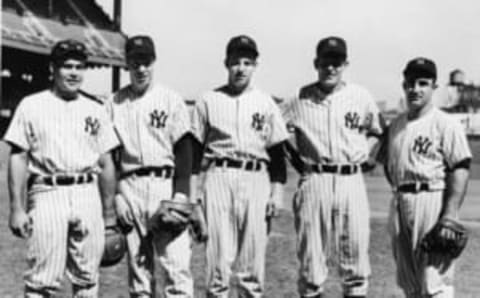
But it isn’t, and the reason is as tragic as that of Thurman Munson, some 40 years later. Lou contracted Amyotrophic Lateral Sclerosis (ALS), now known as Lou Gehrig disease. This disease saps the energy and finally takes the life, from the victim.
Even though this article is pure speculation, it is still too much of a reach to posit a reality in which he had never gotten the disease. But what if he had contracted it just twelve months later?
If that had happened, Gehrig’s numbers would have been vastly different. Even though he must have already been suffering from ALS, he still slashed .295/.410/.523 in 1938. He walked 107 times, drove in 114 runs and hit 29 home runs. That is a career year for a lot of players but is far below his regular production.
In 1937, for instance, Lou slashed .351/.473/.643 with 37 home runs and 158 RBI’s. His OBP led the league for the fourth year in a row, as did his walks (127) for the third year; Joe also led the league for the third time in four years in both OPS (1.116) and OPSplus (176).
The Saddest two letter word is If
The dropoff is most evident in the postseason. By October the disease must have spread, and Joe hit only .286/.375/.286 in the 1938 postseason. And a man who had averaged just under 6 RBI’s in the previous six postseason—and who still holds the AL record for most RBI’s in a season at 184—produced zero in the 1938 WS. Most telling is that his OPS dropped from 1.102 in 1937 to .661 in 1938.
Had it taken just a few more months for Lou to contract ALS, he likely would have very similar production to 1937. And that would have made this already great team even better, perhaps on par with the ’39 or ’61 clubs.
Next: See Five Great Yankees Fourth of July Memorable Moments
But this all just speculation. The Yankees have already fielded some of the best teams of all time; asking for more is just greedy. Still, it is fun to think of what might have been with just a few changes. I can’t help but think of what it might take for the 2017 New York Yankees to be an all-time great team.
Is an entirely new pitching staff too much to ask for?